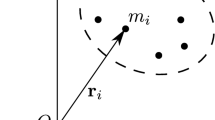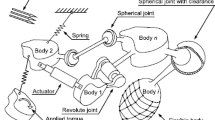Abstract
A method is described for the successive imposition of constraints on a free particle mechanism and the subsequent derivation of closed sets of differential equations for the evolution of the mechanism with time. Fundamental is the idea of ideal constraints as contained in d'Alembert's principle. In particular, it is shown how constraints may be added one or more at a time, thereby obtaining intermediate descriptions with more dynamic freedom than the final mechanism. As a simple example, it is shown that the rigid body is such an intermediate description. The method is also applied to the problem of a chain of n particles or n rigid rods. Both an inductive and a constructive approach are demonstrated in deriving the equations of motion for arbitrary n.
Similar content being viewed by others
References
Arnold, V.I., Mathematical Methods of ClassicalMechanics, Springer-Verlag, New York, 1989.
Kane, T.R. and Levinson, D.A., Dynamics: Theory and Applications, McGraw-Hill, New York, 1985.
Huston, R.L., Multibody Dynamics, Butterworth-Heinemann, London, 1990.
Lesser, M., 'A geometrical interpretation of Kane's equations', Proc. Royal. Soc., London A436, 1992, 69–87.
Lesser, M., The Analysis of Complex Nonlinear Mechanical Systems. A Computer Algebra Assisted Approach, World Scientific, Singapore, 1995.
Blajer, W., 'A projection method approach to constrained dynamic analysis', J. Appl. Mech. 59, 1992, 643–649.
Blajer, W., 'A geometric unification of constrained system dynamics', Multibody System Dynamics 1, 1997, 3–21.
Huston, R.L. and Passerello, C.E., 'On constraint equations - A new approach', J. Appl. Mech. 41, 1974, 1130–1131.
Kamman, J.W. and Huston, R.L., 'Dynamics of constrained multibody systems', J. Appl. Mech. 51, 1984, 899–903.
Schiehlen, W. (ed.), Multibody Systems Handbook, Springer-Verlag, Berlin, 1990.
Jungnickel, U., 'Differential-algebraic equations in Riemannian spaces and applications to multibody system dynamics', Z. Angew. Math. Mech. 74, 1994, 409–415.
Angeles, J., Rational Kinematics, Springer-Verlag, New York, 1988.
Saha, S.K. and Angeles, J., 'Dynamics of nonholonomic mechanical systems using a natural orthogonal complement', J. Appl. Mech. 58, 1991, 238–243.
Goldstein, H., Classical Mechanics, 2nd edn., Addison-Wesley, New York, 1980.
Hamel, G., Theoretische Mechanik, Springer-Verlag, Berlin, 1949, 278–281.
Author information
Authors and Affiliations
Rights and permissions
About this article
Cite this article
Dankowicz, H. On the Successive Constraint Imposition Approach to Multibody Mechanisms. Multibody System Dynamics 3, 267–286 (1999). https://doi.org/10.1023/A:1009886606941
Issue Date:
DOI: https://doi.org/10.1023/A:1009886606941




